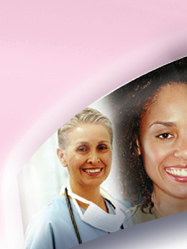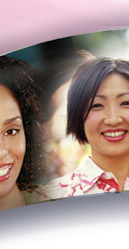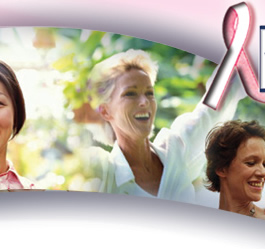|
Now we come to the second element of a breast health program,
breast self-examination (BSE). (Editors Note: For the longest
time it was suggested that women do BSE on a monthly basis
as part of a complete breast health program. In October 2002
the results of an 11-year study completed in Shanghai found
that BSE did not result in earlier detection of breast cancer,
and did result in more biopsies that found more benign breast
lesions. In the U.S. Russell Harris, MD, and Linda Kinsinger,
MD, of the University of North Carolina School of Medicine,
point out that while teaching breast self-exam seems like
a good idea, it is difficult to learn to do well, and is difficult
to do long-term. I’d like to say that the fact that
I found my own breast cancer through BSE even though I was
going for regular mammograms as did a number women I’ve
known makes me believe it does have a valid place in the complete
breast health program. In addition, if done correctly it’s
the only method of early detection for women younger than
age 40 who have no other means of early detection. So read
what follows, learn to become familiar with your breasts,
and report any changes to your health care provider.)
Breast tissue is continually changing. These changes occur
during the monthly cycle and pregnancy, while breast-feeding,
when taking birth control pills and HRT, during menopause,
and to some degree are due to the foods we eat and the medications
we take. Any of these factors can cause fluctuations in the
size, shape and texture of breast tissue. The most common
changes occur in the middle of a woman’s menstrual cycle
when tenderness, fluid retention, and the appearance of lumps
affect the breasts. It’s not unusual for a woman to
notice some variance during the month.
For that reason regular BSE, like mammography, should be
done 7 to 10 days after menstruation begins to minimize the
likelihood breasts will be tender or swollen. If no longer
menstruating, choose a date and mark the calendar as a reminder
(either the first day of each month or your birth date is
a good choice).
Try not to think of BSE as a search for that elusive lump.
Each time you examine your breasts you’ll become more
familiar with how they look and feel, making changes more
recognizable when they do occur. Initially, you might feel
uncomfortable examining yourself, but remember it’s
your body, and the goal is to provide it with the best possible
care. If you do find a suspicious lump or notice a change
in your breast, be sure to have it checked out by your health
care provider.
There’s no need to become obsessive about examining
your breasts. When first learning to do BSE it helps to practice
it more frequently just as a means of increasing familiarity
with a part of your body that deserves special attention.
When you feel comfortable with the process, once a month is
all that is required, unless your physician suggests otherwise
(keep in mind each woman’s breasts typically vary from
slightly to greatly in size.)
Choose the pattern you’re most comfortable with as
long as you cover the entire breast area in your examination,
from the underarm across to the breastbone, and from the ridge
below the breast up to the collarbone.
VERTICAL ROW: Begin at the underarm area
and work your way across to the breastbone in an up and down
pattern.
SPIRAL (circular): Begin at the outer edge
and move your fingers in a spiral toward the nipple covering
the entire breast area.
WEDGE: Think of a clock. Move your fingers
from the outer edge toward the nipple beginning at 12 o’clock,
then reversing back toward the outer edge continue clockwise
around the entire breast area.
 top
of page top
of page
How To Perform the Exam
A good time to do BSE is just before bathing, or whenever
you’re able to find some private time for yourself.
Let's go over the steps involved.
 Step
#1: Stand in front of a mirror with your arms at your sides.
Look for anything that appears to be unusual for your breasts.
Puckering or dimpling on the surface of the breast or nipple,
scaling of the skin, any discoloration, or a discharge from
the nipples are all signs that something is occurring within
the breast tissue. Notice the shape of your breasts —
you’ll be looking for symmetry. Turn sideways towards
the right and then the left to allow a side view of each breast. Step
#1: Stand in front of a mirror with your arms at your sides.
Look for anything that appears to be unusual for your breasts.
Puckering or dimpling on the surface of the breast or nipple,
scaling of the skin, any discoloration, or a discharge from
the nipples are all signs that something is occurring within
the breast tissue. Notice the shape of your breasts —
you’ll be looking for symmetry. Turn sideways towards
the right and then the left to allow a side view of each breast.
 Step
#2: Raise your arms and clasp your hands behind your head
and press our elbows backward to expand the chest area. Look
for any changes that alter the contour of your breast. Again,
these would be swelling, dimpling, discoloration, and asymmetry. Step
#2: Raise your arms and clasp your hands behind your head
and press our elbows backward to expand the chest area. Look
for any changes that alter the contour of your breast. Again,
these would be swelling, dimpling, discoloration, and asymmetry.
 Step
#3: Put your hands on your hips and bend slightly forward
until your nipples point down. Check the front and side views
for any change in the shape or contour of your breasts. Step
#3: Put your hands on your hips and bend slightly forward
until your nipples point down. Check the front and side views
for any change in the shape or contour of your breasts.
 top
of page top
of page
In Steps #4, and #5 you will be feeling for any unusual lump
or mass under the skin. Breast tissue is composed of fatty
tissue, glands, ligaments, and milk ducts so they won't feel
absolutely smooth beneath the surface, but more like hills
and valleys. A lump is unusual if you haven’t felt it
during earlier breast examinations — assuming this isn’t
the first time you’re examining your breasts —
and it now stands out against the texture of your breast.
If something feels different to you, check the opposite breast
for a similar ridge or bumpy area in the same location since
it may just be part of your particular breast landscape. When
there is a noticeable difference be sure to have it checked
out by your health care provider.
 |
With the top joint of the middle three fingers (the
padded portion not the tip) held in a relaxed position,
follow the contour of your breast utilizing the pattern
you’ve chosen. Holding the three fingers close together,
move them in dime-size circles in an overlapping pattern
of a finger's width. |
 Use
three levels of touch throughout each step of the examination:
light pressure to feel just under the skin; medium pressure
to feel the tissues of the breast; and firm pressure extending
as far down toward the chest wall as you can without discomfort. Use
three levels of touch throughout each step of the examination:
light pressure to feel just under the skin; medium pressure
to feel the tissues of the breast; and firm pressure extending
as far down toward the chest wall as you can without discomfort.
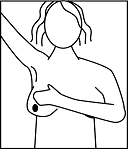 Step
#4: Either sitting on a bed or standing raise your right arm.
Using the pattern of choice thoroughly examine your right
breast with your left hand. Change hands and examine your
left breast. You may want to repeat Step #4 in the shower
where your fingers will glide easily over your soapy skin,
allowing you to concentrate on feeling for changes. Step
#4: Either sitting on a bed or standing raise your right arm.
Using the pattern of choice thoroughly examine your right
breast with your left hand. Change hands and examine your
left breast. You may want to repeat Step #4 in the shower
where your fingers will glide easily over your soapy skin,
allowing you to concentrate on feeling for changes.
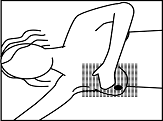 Step
#5: Lie down and place a folded towel under your right shoulder.
Raise your right arm above your head. Examine the right breast
covering the area from the underarm across to the sternum
(middle of your rib cage), up to the collarbone and down to
the lower bra line (the bony ridge just below your breast).
Repeat the process on your left breast. Step
#5: Lie down and place a folded towel under your right shoulder.
Raise your right arm above your head. Examine the right breast
covering the area from the underarm across to the sternum
(middle of your rib cage), up to the collarbone and down to
the lower bra line (the bony ridge just below your breast).
Repeat the process on your left breast.
For large breasted women: To achieve a better exam lie down,
bend your knees, and roll toward the left so that your right
nipple is pointing up. With right arm raised above your head
and a towel beneath your shoulder, examine the outer portion
of your right breast from the underarm area to the nipple
between the area of the collarbone to the lower bra line.
Without lifting your fingers, straighten your legs and roll
onto your back and examine the inner half of the breast from
the nipple to the breastbone. Reverse the process on your
left breast.
For most women BSE takes about 15 minutes. If done on a
regular basis, it becomes a habit — one that’s
certainly well worth developing.
 Clinical
Breast Exams Clinical
Breast Exams
|
